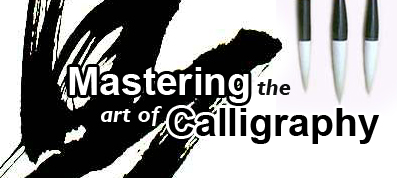
Dates: Tuesdays, February 19, 26;
March 4, 11, 18, 25; April 1 & 8 2008
Time: 6:30PM – 8PM
Place: 25 West 43rd Street, Room 1000
between 5th & 6th Avenues, Manhattan
Fee: $250 (Non-Member) | $150 (Member/Student)
Click Here to learn how to become a member.
Supplies will be provided by the instructor during the first day of class.
No prior experience is necessary to join this workshop.
Learn basic Chinese calligraphy in a total of eight sessions.
Please make checks payable to: QCAF-AAARI
The Chinese esteem calligraphy above all other arts. While the characters have an aura of mystery, anyone can learn how to form them. In this course, you will learn the few simple rules for writing in Chinese. Each session will begin with a brief explanatory talk illustrated with examples of the great calligraphy of the past. Most of each class will be devoted to actually doing calligraphy.
Chinese believe that calligraphy exercises both body and mind. As a form of meditation it is thought to promote concentration, relaxation, and longevity. As you brush the characters onto the paper, you will be able to feel your qi (vital energy) circulate, producing a feeling of relaxation. By the end of the course, you will be creating elegant characters using traditional materials. Please come and join this informative, relaxing and fun course!
Workshop Syllabus
Session 1
- Origin and Development of Chinese Calligraphy
Slide show: The beauty of Lines in Chinese Calligraphy and Culture. - Basic materials: brush, brush holder, ink, rice paper, grid paper, ink stone, small dish, paper weight, and others (wrist rest, seal).
- Introducing “Four treasures of the literary studio”
- Rituals: incense burning, meditation, relaxed breathing.
- Demonstration: how to hold a brush and form characters.
- Handout: standard script model calligraphy
- Practice standard script on grid paper.
Session 2
- Slide show: Calligraphy as an Art Form: philosophy of yin and yang as exemplified in different brush strokes: centered, diagonal, wet, dry, “flying white.”
- Techniques of Chinese calligraphy:
- What makes a good stroke
- Mistakes to avoid.
- Analysis of the character “Yong” eternity, exemplifying the basic structure of Chinese calligraphic strokes
- Demonstration
- Practice different strokes of standard script on grid paper to form a character
Session 3
- Seal Script: ancient characters on bronze vessels, characteristics and aesthetics
- Demonstration
- Handout: seal script model calligraphy
- Practice on grid paper
Session 4
- Benefiting from the Dancing Brush: calligraphy and longevity, relaxation, concentration, energy circulation, inner peace.
- Demonstration: Official script
- Handout: official script model calligraphy
- Practice your favorite characters
Session 5
- Walking style: characteristics and aesthetics
- Demonstration
- Handout: walking style model calligraphy
- Practice: walking style free hand.
Session 6:
- Slide show: Calligraphy as decoration
- Demonstration
- Practice: walking style free hand.
Session 7
- Slide show: The Drunken Calligrapher
- Cursive and mad cursive: characteristics and aesthetics
- Handout: cursive style model calligraphy
- Demonstration
- Practice: cursive style free hand
Session 8
- Different Formats for Calligraphy: hanging scrolls, double scrolls, fans, and others.
- Write your favorite lucky character on red paper to bring home.
- Critique and appreciation of each others’ works.
Make-up Classes: Tuesday, April 15 & 22, 2008 – To be held if the instructor is unable to hold a classes on normal schedule.
